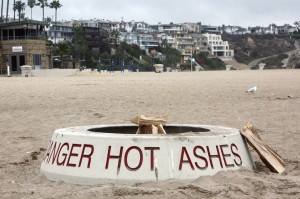 Adding fuel to the fire ring debate, charcoal will soon be the only acceptable source for beach bonfires.
Adding fuel to the fire ring debate, charcoal will soon be the only acceptable source for beach bonfires.
Although the City Council approved an ordinance on Tuesday that allows other forms of fuel (but limits them to natural wood, natural gas, fire logs and charcoal), a South Coast Air Quality Management District rule that will go into effect on March 1 narrows those choices down even further to just charcoal.
The ordinance passed 6-1, with councilwoman Leslie Daigle dissenting. There will be a second reading on Feb. 11.
City Manager Dave Kiff explained that once SCAQMD Rule 444 goes into effect on March 1, unless the rings are spaced further apart or several are removed, charcoal would be the only acceptable source of fuel. According to Rule 444, fire rings need to be a certain distance from each other and residences if they are going to burn other types of material.
Council had voted in November to remove rings, but the plan was not found to be acceptable by AQMD or the California Coastal Commission.
However, beachgoers will only be limited to charcoal until the city gets a Coastal Development Permit from the California Coastal Commission. The permit will then allow the city to space the rings further apart, which will then allow beachgoers to burn the fuel sources acceptable in the city’s ordinance.
Overall, the ordinance allows city to come into compliance with AQMD rule 444, while in the interim processing the Coastal Development Permit needed to be able to burn other fuel sources.
If the city does not comply with rule 444 by the deadline they could be penalized by the AQMD. Fines could be per violation, Kiff said, and could total up to thousands of dollars for every day out of compliance.
Council members also discussed how bill AB 1102, recently passed by state Assembly, would affect the city. The state bill still needs to be passed by the Senate.
Should AB 1102 pass in the Senate, it would require the city to obtain a Coastal Development Permit from the CCC, which could take quite some time, Kiff said. The bill would not go into effect until Jan. 1, 2015.
If the assembly bill was to pass, the city’s newly approved rule would no longer be effective until the city got a CDP from the commission approving the ordinance, city attorney Aaron Harp explained.
The latest version of the bill doesn’t limit AQMD’s rulemaking or effect rule 444, Kiff clarified, but it does state that the only way a locality can implement that rule is by getting a CDP.
“And it says that in seeking that Coastal Development Permit, the locality has to show how complying with the rule does not, in the state’s eyes, violate the state’s preference for no net loss in fire rings,” Kiff explained.
Most council members expressed their frustration of being caught between the two agencies.
“So we are caught between two state regulatory agencies with conflicting purposes, with conflicting goals, trying to do conflicting things,” said councilman Keith Curry. “None of these ideas are going to make anybody happy… Charcoal makes nobody happy. It doesn’t make me happy. I can’t imagine it makes anybody happy.”
This rule allows the city to avoid fines and let the two state agencies “sort it out amongst themselves” about the regulations, he continued.
It also means that in the long run, natural firewood will be allowed in the fire rings that aren’t burning alternative fuels, councilman Ed Selich explained.
Natural wood is part of the problem, said Corona del Mar resident Frank Peters, who lives within 525 feet of the fire rings.
Councilwoman Nancy Gardner made a motion to approve the ordinance, excluding natural wood, but received no second motion.
If it really is a health issue, and Gardner believes it is, then natural wood should not be allowed, she suggested.
Resident Jim Mosher wondered if the ordinance applied to private beach fire rings, because they are exempt from AQMD rule 444, he said.
“Which makes one really wonder the extent to which it is based on true health concerns,” Mosher said.
Daigle made a motion to “get out of this whole fire ring business,” which received some applause from the audience.
“The problem with that motion is that we can’t,” Curry replied. “Because we have a state agency that’s going to tell us on March 1 that we are responsible for regulating what people burn in the fire pit or we face being fined. And we have another agency that’s telling us, ‘Wait a minute. You can’t restrict what people can burn in that fire pit without a Coastal Development Permit and we can’t give you one until August.’”
On top of that, the state law will likely play into the situation, he added.
Peters urged the council to comply with the AQMD rule.
“Charcoal wasn’t on my radar until just a few nights ago,” Peters said. “If that works for the AQMD, it works for me.”
As a longtime champion for removing the fire pits, Peters said he realized something surprising while documenting people using them.
“I see the human experience that’s occurring down there at the fire pits and I realized that I undervalued that, that I did not weigh that as valuable,” he said. “My opinion of what’s occurring down at the fire rings has changed.”




